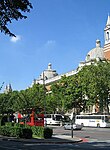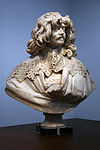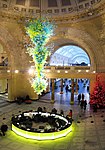Thurloe Square

Thurloe Square is a traditional garden square in South Kensington, London, England. There are private communal gardens in the centre of the square for use by the local residents. The Victoria and Albert Museum is close by to the north across Thurloe Place and Cromwell Gardens. The nearest tube station is South Kensington to the west along Thurloe Street. The square (and the adjacent streets) are named after John Thurloe, an advisor of Oliver Cromwell, who owned the land in the 17th century. His descendant, Harris Brace, had a godson called John Alexander, who developed the area in the 1820s. George Basevi designed most of the houses.Sir Henry Cole (1808–1892), the first director of the Victoria and Albert Museum, lived at 33 Thurloe Square just opposite the museum. The building is marked with a blue plaque and is now the Kazakhstan Embassy. The house at 5 Thurloe Square is very narrow, wedge-shaped, and only six feet wide at one end. The homeopath Margery Blackie lived and practised at no. 18 from 1929 to 1980. The building is marked with a blue plaque.The Yalta Memorial Garden, which contains a memorial to those repatriated as a result of the Yalta Conference following World War II, Twelve Responses to Tragedy, is situated at the north of the square between the square and the Cromwell Road.
Excerpt from the Wikipedia article Thurloe Square (License: CC BY-SA 3.0, Authors, Images).Thurloe Square
Thurloe Street, London Brompton (Royal Borough of Kensington and Chelsea)
Geographical coordinates (GPS) Address External links Nearby Places Show on map
Geographical coordinates (GPS)
| Latitude | Longitude |
|---|---|
| N 51.494722222222 ° | E -0.17194444444444 ° |
Address
Thurloe Square Garden
Thurloe Street
SW7 2SS London, Brompton (Royal Borough of Kensington and Chelsea)
England, United Kingdom
Open on Google Maps










